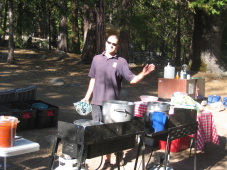 Michael,
our host and cook from the Yosemite
Institute, is setting up the kitchen. The Yosemite Institute is
another non-profit that brings 13,000 kids to Yosemite each year, for
a learning/camping/hiking experience. The group that organizes the
volunteer work week, a non-profit called the
Yosemite Association, taps the
expertise of YI to provide the host and cook.
Michael,
our host and cook from the Yosemite
Institute, is setting up the kitchen. The Yosemite Institute is
another non-profit that brings 13,000 kids to Yosemite each year, for
a learning/camping/hiking experience. The group that organizes the
volunteer work week, a non-profit called the
Yosemite Association, taps the
expertise of YI to provide the host and cook.
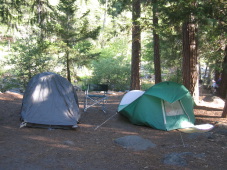 My sorry tent is the gray one on the left. My carpooler's tent, the green one on the right, is put up with scout care and precision.
My sorry tent is the gray one on the left. My carpooler's tent, the green one on the right, is put up with scout care and precision.
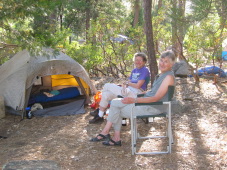 From the left: Verle's tent, Verle from Los Gatos, and my carpool companion from Palo Alto, Ann. Tents up, we're waiting for dinner.
From the left: Verle's tent, Verle from Los Gatos, and my carpool companion from Palo Alto, Ann. Tents up, we're waiting for dinner.
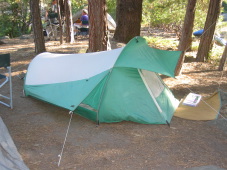 A close-up of Ann's tent, so she can prove to her husband she put it up perfectly.
A close-up of Ann's tent, so she can prove to her husband she put it up perfectly.
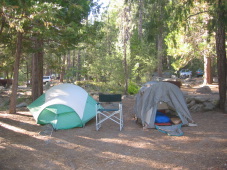 A view of
our little neighborhood from the river. Our tents were about 40 feet
from the cool water that talked to us all night and all day. We
really had a lovely group campsight (45, 46, 47 in Wawona, if anyone ever
wants to reserve a campsight in Wawona.) It's far from the campground
entrance, and it's blessed with a lot of trees. Not very close to the
restroom, but you can't have everything.
A view of
our little neighborhood from the river. Our tents were about 40 feet
from the cool water that talked to us all night and all day. We
really had a lovely group campsight (45, 46, 47 in Wawona, if anyone ever
wants to reserve a campsight in Wawona.) It's far from the campground
entrance, and it's blessed with a lot of trees. Not very close to the
restroom, but you can't have everything.
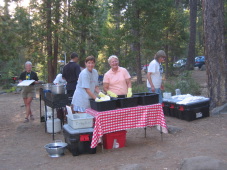 After
dinner on Sunday, Rose and Barbara do the dishes. We use three pans:
hot water to wash, cold water to rinse, and then a dilute bleach
solution to rinse the dishes one more time, as a sort of disinfectant
step. We have to boil the water on the camp stove (does this sound
familiar to anyone?) and also fetch all the water from a spot a couple
hundred feet up the slowly slanting hill (and does THAT sound
famililar?!)
After
dinner on Sunday, Rose and Barbara do the dishes. We use three pans:
hot water to wash, cold water to rinse, and then a dilute bleach
solution to rinse the dishes one more time, as a sort of disinfectant
step. We have to boil the water on the camp stove (does this sound
familiar to anyone?) and also fetch all the water from a spot a couple
hundred feet up the slowly slanting hill (and does THAT sound
famililar?!)
Monday, July 12:
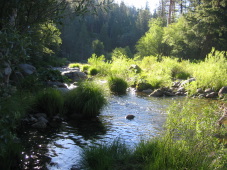 The sun on the Merced river early in the morning. We generally got up anywhere from 6 to 6:30 (although Michael, our cook, got up at 5:30) and breakfast was at 7. Coffee available at 6:30. Make bag lunches after breakfast, and wait for our National Park Service Leader Par Excellence, Noreen, to come fetch us for the day's work.
The sun on the Merced river early in the morning. We generally got up anywhere from 6 to 6:30 (although Michael, our cook, got up at 5:30) and breakfast was at 7. Coffee available at 6:30. Make bag lunches after breakfast, and wait for our National Park Service Leader Par Excellence, Noreen, to come fetch us for the day's work.
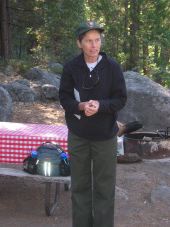 Noreen!
She has been working for the Park Service for 27 years, and right now
works for Resource Management Restoration. She is the absolute point
person, the one herding us and getting us to do something useful. She
lives in a little house in Foresta, an area inside the park, with her
husband and garden. Foresta is the area that was devastated by a huge
fire a few years ago; most structures in Foresta burned. Theirs was
spared.
Noreen!
She has been working for the Park Service for 27 years, and right now
works for Resource Management Restoration. She is the absolute point
person, the one herding us and getting us to do something useful. She
lives in a little house in Foresta, an area inside the park, with her
husband and garden. Foresta is the area that was devastated by a huge
fire a few years ago; most structures in Foresta burned. Theirs was
spared.
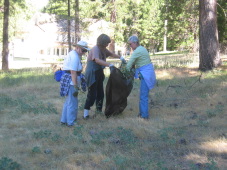 Our first
day of weeding consisted of searching for a particular kind of mustard
plant in a large field out back of Wawona Hotel, and yanking it up
including the roots, and putting it in a large trash bag. There were
11 volunteers plus Noreen combing the field. It was hot work - most
of the time we were in the sun.
Our first
day of weeding consisted of searching for a particular kind of mustard
plant in a large field out back of Wawona Hotel, and yanking it up
including the roots, and putting it in a large trash bag. There were
11 volunteers plus Noreen combing the field. It was hot work - most
of the time we were in the sun.
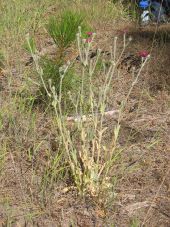 Mullin
pink, another exotic that we pulled in the forest and fields around
Wawona. It looks lovely, with its dark pink flower, but it had to go.
Mullin
pink, another exotic that we pulled in the forest and fields around
Wawona. It looks lovely, with its dark pink flower, but it had to go.
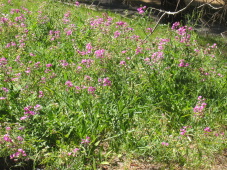 A sea of lavendar
blossoming sweet pea, also targeted for eventual removal. We didn't get
to this during our work week. Sweet pea is hard, in that it has an underground
interwoven nest of roots that have to be dug up.
A sea of lavendar
blossoming sweet pea, also targeted for eventual removal. We didn't get
to this during our work week. Sweet pea is hard, in that it has an underground
interwoven nest of roots that have to be dug up.
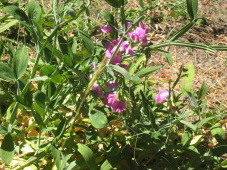 A closer look at the doomed sweet pea.
A closer look at the doomed sweet pea.
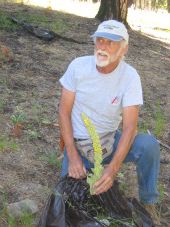 Foreman
Jerry, on his third work week this year. Jerry is a permanent RV'er.
He's holding her a kind of mullin, I think, that we pulled out. Its
stem is exploding towards seed, so we got this one just in time.
Foreman
Jerry, on his third work week this year. Jerry is a permanent RV'er.
He's holding her a kind of mullin, I think, that we pulled out. Its
stem is exploding towards seed, so we got this one just in time.
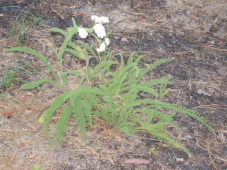 To my untutored eye, this is yarrow. Corrections?
To my untutored eye, this is yarrow. Corrections?
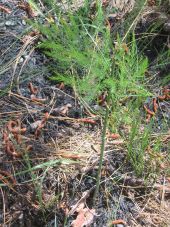 Well, 5 days or so after the fact, I have no idea. Your suggestions welcome.
Well, 5 days or so after the fact, I have no idea. Your suggestions welcome.
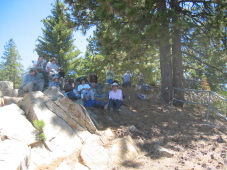 Lunch the first day. It was quite hot in the sun.
Lunch the first day. It was quite hot in the sun.
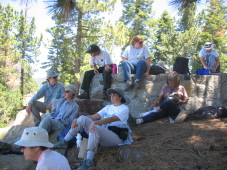 A closer look at the lunching.
A closer look at the lunching.
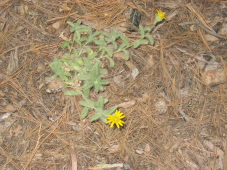 Hulsea
brevifolia, the rare plant of our desire that afternoon. She was not
to be found outside the one grand patch, hidden away in the Mariposa
Grove. We walked the whole of the grove. We know. See also
Hulsea brevifolia, as per California Native Plant Society.
Hulsea
brevifolia, the rare plant of our desire that afternoon. She was not
to be found outside the one grand patch, hidden away in the Mariposa
Grove. We walked the whole of the grove. We know. See also
Hulsea brevifolia, as per California Native Plant Society.
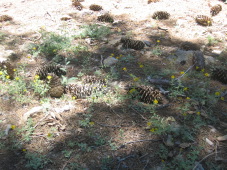 She is scattered among the pine cones, or, the pine cones are scattered among her plot.
She is scattered among the pine cones, or, the pine cones are scattered among her plot.
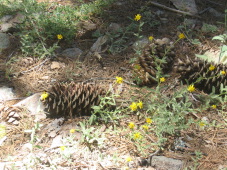 Dangerously close to The Art Shot!
Dangerously close to The Art Shot!
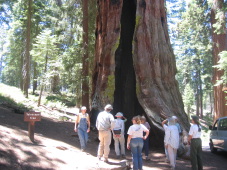 When in Mariposa Grove, stop and admire the wondrous trees.
When in Mariposa Grove, stop and admire the wondrous trees.
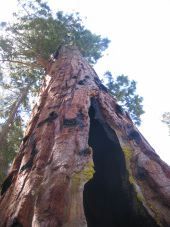 I have this irrespresible urge to look up towards the tree's canopy.
I have this irrespresible urge to look up towards the tree's canopy.
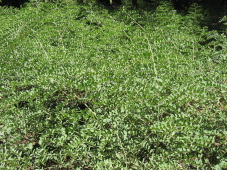 A lotus field.
A lotus field.
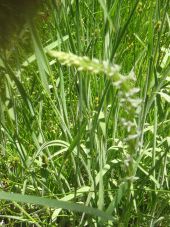 The rain orchid (this one is artistically bent; generally, they are straight up and tall.)
The rain orchid (this one is artistically bent; generally, they are straight up and tall.)
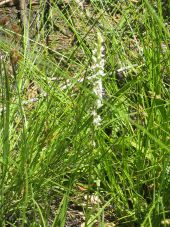 Rain orchid, standing tall.
Rain orchid, standing tall.
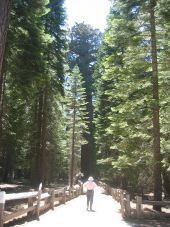 Verle looks up at the avenue of giant Sequoias.
Verle looks up at the avenue of giant Sequoias.
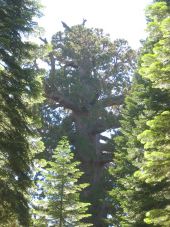 The twisted, gnarled yet independent arms of the giant tree. Sorry for washout. My bad.
The twisted, gnarled yet independent arms of the giant tree. Sorry for washout. My bad.
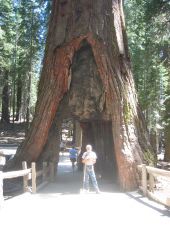 Another utterly washed out shot, BUT, I do believe that's Jerry and his hard-working shovel!
Another utterly washed out shot, BUT, I do believe that's Jerry and his hard-working shovel!
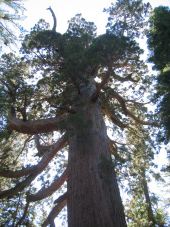 It is impossible not to gaze upwards at the crown; the trees pull your gaze, make you crane your head back, and stare in disbelief at the mass of trunk and branches and leaf and cone that rise hundreds of feet above your feet, trampling as they are on her poor suffering roots.
It is impossible not to gaze upwards at the crown; the trees pull your gaze, make you crane your head back, and stare in disbelief at the mass of trunk and branches and leaf and cone that rise hundreds of feet above your feet, trampling as they are on her poor suffering roots.
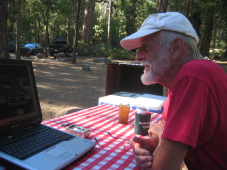 Proof! as if any were needed - we are still computerized here in our campground. Jerry brings up his laptop and shows wonderful pictures of nature, and the unfortunate intersection of nature and car (a tree fell on a car.)
Proof! as if any were needed - we are still computerized here in our campground. Jerry brings up his laptop and shows wonderful pictures of nature, and the unfortunate intersection of nature and car (a tree fell on a car.)
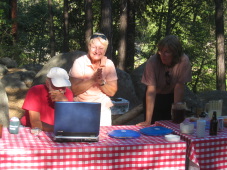 I have no idea what is delighting Barbara, but I want some of it! Jerry to the left, Belinda in the shadows to the right.
I have no idea what is delighting Barbara, but I want some of it! Jerry to the left, Belinda in the shadows to the right.
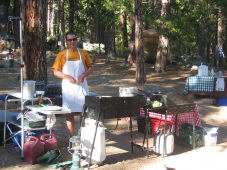 Now this is agreed upon by all to be the nicest (and handsomest) possible campsite host and cook, Michael. Michael usually works for Yosemite Institute (the kids) but he's on loan to us this week.
Now this is agreed upon by all to be the nicest (and handsomest) possible campsite host and cook, Michael. Michael usually works for Yosemite Institute (the kids) but he's on loan to us this week.
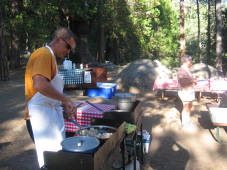 Michael slaving away. We really had quite gourmet meals.
Michael slaving away. We really had quite gourmet meals.
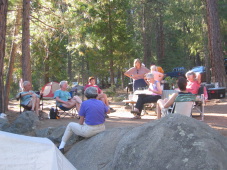 After dinner? Before dinner? Whatever - our group sprawled, relaxing, around the campsites in Wawona Campground.
After dinner? Before dinner? Whatever - our group sprawled, relaxing, around the campsites in Wawona Campground.
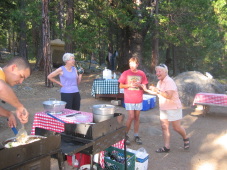 Left to right: Michael, our cook; Kate, our botanist/librarian from UC Davis; Rose, general contractor; Barbara, free spririt and consummate volunteer from San Diego.
Left to right: Michael, our cook; Kate, our botanist/librarian from UC Davis; Rose, general contractor; Barbara, free spririt and consummate volunteer from San Diego.
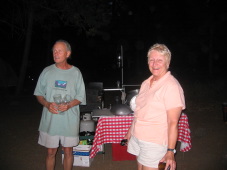 Don and Barbara - hey Barbara, I seem to be capturing you rather a lot!
Don and Barbara - hey Barbara, I seem to be capturing you rather a lot!